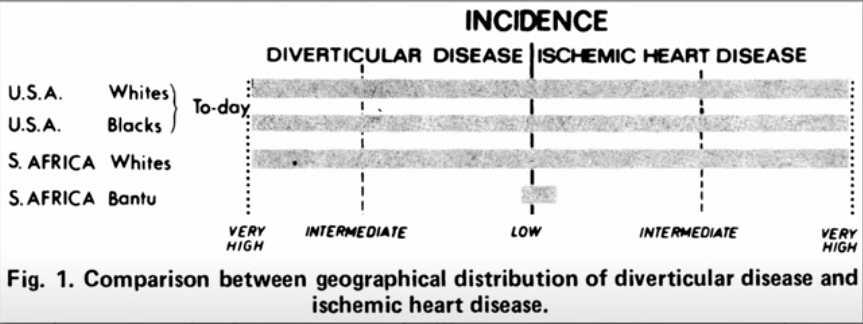Excerpts from A Review of Medical Literature on Relationships of Various Degenerative Diseases to Diet and Activity (1988) by Nathan Pritikin:
Heart Disease (pages 19-20):
Bantus of central and southern Africa have not yet entered the stream of civilization sufficiently to change their age-old life patterns. Their food intake limits fat to 10% of total calories compared to 40+% in the U.S. diet. Daily cholesterol intake is probably under 100 mg. This is reflected in their blood levels.[19] In healthy Bantu schoolchildren, lipids are very low: triglycerides average 48 mg., cholesterol levels are from 90-120 mg., and fasting glucose is so low at 43 mg., that it would be considered hypoglycemic in American children.
The incidence of coronary heart disease among the Bantu is almost zero. At the Knana Nune Hospital, which has 300 beds for Africans, the autopsy rate is high, but no deaths from coronary heart disease were found over a 5-year period (1948-53). During this same period, in the European wing of 40 beds, 23 deaths were attributed to coronary heart disease.[17] In autopsies performed at the hospital on 42 Africans and 22 Europeans who had died suddenly for any reason, only one African had extensive atheroma, while 35 lacked even a plaque or trace of damage. By contrast, all 22 Europeans had extensive damage, even a youth of 15.
Pages 65-66:
Fat intake and lipid levels
When the low incidence of coronary heart disease among such groups at the Bantu is accredited to their low-fat diet, many argue that their immunity is a racial characteristic--but this is merely wishful thinking! This is shown by the following study. Long-term inmates in a South African prison were selected to test their response to a 40% fat diet.[113] Half were whites; the other half were native Bantus. Average age was 37 years and all were tested to exclude any with apparent abnormalities. Their diet in the prison had 15% of total calories in fat. For the test, fats were raised to 40% of total calories, with butter providing 25% of were raised to 40% of total calories, with butter providing 25% of weeks on this diet are shown.

The triglyceride values of Bantu natives not only are affected by fat content but overreact as compared to whites. Although they were at the same level as the whites in the beginning, by 51 weeks the Bantus' triglycerides were 20% higher; and after 30 weeks on their control diet they were 12% lower than the whites.
Diabetes: Pages 440-441:
Bantu children on a diet very high in cereals, with very little animal protein, fats or sugar show the typical response to sugar and fat clearance expected with these diets. Eighty childrenp [112] 10 to 12 years old, were found to have a glucose fasting level of 43 mg. This would be considered hypoglycemic for subjects on a Western diet. When these children ingested 50 gms. of glucose (well over 1 gm. of glucose per kg. of weight), the one hour glucose level was only 54 mg., half the value that would be found in Western children. Their handling of fats was just as efficient. Fasting levels of triglycerides were 48 mg. With a load of 56 gm. of butter, the triglycerides rose in 3 hours to only 78 mg. This would be considered a good fasting level for Western children. The ability of these children to handle large loads of sugar or fat and efficiently remove them from the blood is not found in subjects on Western diets. Bantus over 60 years respond to fat and sugar clearance as do the Bantu children.
It has been said that the reason for the Bantus' low lipid levels must be genetic,[113] perhaps racial differences, or due to a variety of other causes—except diet. Bantus, however, respond to dietary changes as quickly as any Western white person.
This response to dietary change by Bantus was demonstrated in a study of South African white and Bantu long-term prisoners. The prisoners, aged 21 to 54 years, free of any disease, were tested on different diets. On a basal diet of 15% fat and 70% carbohydrate, both groups had triglyceride levels that were not significantly different. When the diets were changed to 40% fat, but with the same total calorie level, each group showed a substantial increase in the triglyceride level. There was no racial difference in this response.
Further evidence demonstrates that the Bantu's freedom from diabetes does not have a hereditary basis. Bantus who live in the large cities and adopt the standard dietary practices existing there become diabetic just as often as the whites. In a survey[114] done in Cape Town, the incidence of diabetes for those over 15 years of age was 3.2% for the whites and 3.6% for the Bantus. Another study made in Johannesburg[115] found a substantial diabetic population not only among the Bantu, but also among the Zulu and several other African tribal groups. These diabetics, many of them skilled workers, most of whom had lived in the city for at least 20 years, had long since adopted the characteristic diet of urban dwellers.
Lipid levels are controlled by diet&mdsah;age, sex and race are inconsequential. Although a primitive diet may not appeal to Western tastes, the dietary direction in which we must proceed is clear, if hyperglycemia and diabetes are to be eliminated. Highcomplex carbohydrate, low-fat diets are antidiabetogenic; Western diets of high fats and simple carbohydrates make the diabetic state inevitable.
Calcium: Pages 508-509:
Calcium
One example is calcium. Requirements for calcium are controversial. The average recommended intake in the U.S. is 100 mg. per day. Yet the World Health Organization in their report on calcium requirements[8] states: "No frank signs of calcium deficiency have ever been described in any part of the world, even in populations with an habitually low calcium intake." Many population groups subsist on intakes of 200 mg. per day and show no signs of calcium deficiency.
One such group is the Bantu population in Africa.[9] They not only get along well, but have great bone density. They also enjoy freedom from caries, rickets, osteomalacia (adult rickets), and osteoporosis, and have good healing of fractures. Children subsist completely on mother's milk for six months and during that time grow as rapidly as Caucasian babies (even though as adults they do not reach Caucasian stature). Low calcium intake is no disadvantage to this population group.
What happens with high intakes of calcium? In farm animals, high intakes of calcium have produced deficiencies of iron, zinc, and magnesium and have, in addition, resulted in impaired utilization of protein and fat.


 Instagram
Instagram YouTube
YouTube